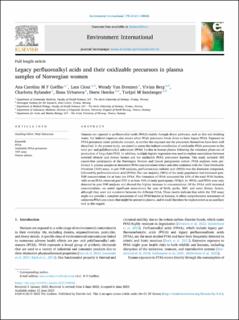| dc.contributor.author | Miranda Fernandes Coelho, Ana Carolina | |
| dc.contributor.author | Cioni, Lara | |
| dc.contributor.author | Van Dreunen, Wendy | |
| dc.contributor.author | Berg, Vivian | |
| dc.contributor.author | Rylander, Karin Charlotta Maria | |
| dc.contributor.author | Urbarova, Ilona Halva | |
| dc.contributor.author | Herzke, Dorte | |
| dc.contributor.author | Sandanger, Torkjel M | |
| dc.date.accessioned | 2023-09-18T09:29:47Z | |
| dc.date.available | 2023-09-18T09:29:47Z | |
| dc.date.created | 2023-07-17T13:13:05Z | |
| dc.date.issued | 2023 | |
| dc.identifier.citation | Environment International. 2023, 178, 108026. | en_US |
| dc.identifier.issn | 0160-4120 | |
| dc.identifier.uri | https://hdl.handle.net/11250/3090016 | |
| dc.description.abstract | Humans are exposed to perfluoroalkyl acids (PFAA) mainly through direct pathways, such as diet and drinking water, but indirect exposure also occurs when PFAA precursors break down to form legacy PFAA. Exposure to PFAA precursors raises particular concern, as neither the exposure nor the precursors themselves have been well described. In the present study, we aimed to assess the indirect contribution of oxidizable PFAA precursors to the total per- and polyfluoroalkyl substances (PFAS) burden in human plasma following the voluntary phase-out of production of long-chain PFAS. In addition, multiple logistic regression was used to explore associations between selected lifestyle and dietary factors and the oxidizable PFAA precursors fraction. This study included 302 cancer-free participants of the Norwegian Women and Cancer postgenome cohort. PFAS analyses were performed in plasma samples to determine PFAS concentrations before and after oxidation with the Total Oxidizable Precursor (TOP) assay. In pre-TOP analyses, perfluorooctane sulfonic acid (PFOS) was the dominant compound, followed by perfluorooctanoic acid (PFOA).The vast majority (98%) of the study population had increased post-TOP concentrations for at least one PFAA. The formation of PFAA accounted for 12% of the total PFAS burden, with seven PFAA observed post-TOP in at least 30% of study participants. PFHpA, br- PFOA, and PFDA were only detected in post-TOP analyses and showed the highest increase in concentrations. Of the PFAA with increased concentrations, we noted significant associations for year of birth, parity, BMI, and some dietary factors, although they were not consistent between the different PFAA. These results indicate that while the TOP assay might not provide a complete assessment of total PFAS burden in humans, it offers comprehensive assessment of unknown PFAA precursors that might be present in plasma, and it could therefore be implemented as an auxiliary tool in this regard. | en_US |
| dc.language.iso | eng | en_US |
| dc.rights | Navngivelse 4.0 Internasjonal | * |
| dc.rights.uri | http://creativecommons.org/licenses/by/4.0/deed.no | * |
| dc.title | Legacy perfluoroalkyl acids and their oxidizable precursors in plasma samples of Norwegian women | en_US |
| dc.title.alternative | Legacy perfluoroalkyl acids and their oxidizable precursors in plasma samples of Norwegian women | en_US |
| dc.type | Peer reviewed | en_US |
| dc.type | Journal article | en_US |
| dc.description.version | publishedVersion | en_US |
| dc.rights.holder | © 2023 The Authors. Published by Elsevier Ltd. | en_US |
| dc.source.volume | 178 | en_US |
| dc.source.journal | Environment International | en_US |
| dc.identifier.doi | 10.1016/j.envint.2023.108026 | |
| dc.identifier.cristin | 2162535 | |
| dc.source.articlenumber | 108026 | en_US |
| cristin.ispublished | true | |
| cristin.fulltext | original | |
| cristin.qualitycode | 1 | |

